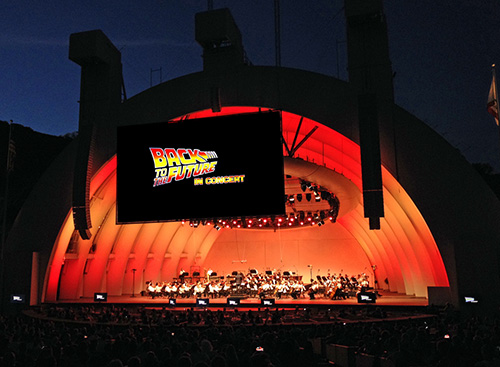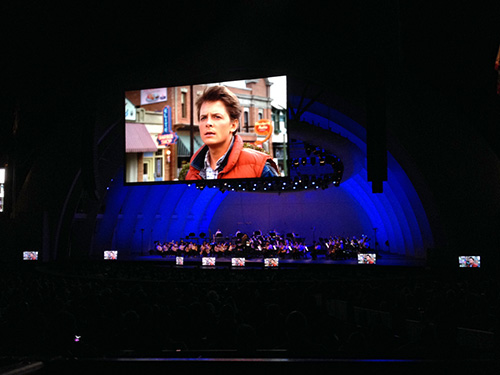

  |
|
|
||||||||||||||||||||||
|
FMS FEATURE... July 1, 2015 Back to the Future – Live at the Hollywood Bowl Silvestri score performed by L.A. Phil to cheering crowd by Jon Burlingame  Photo by Marilee Bradford Writer-producer Bob Gale introduced the evening by proclaiming that this was "the largest audience in the world ever to see Back to the Future in one place," drawing cheers from the enthusiastic, near-capacity crowd, which watched the 1985 classic unspool on three huge screens. Conductor David Newman, a familiar figure at the Bowl for his many classic-film-music programs, put the Philharmonic through its paces during the two and a half hour show. It was an unusual assignment for the 80-member ensemble, whose Tuesday-night concerts are typically "classical" music. (Assistant concertmaster Mark Baranov was the sole member of the orchestra who also played on the film's 1985 recording sessions.) Musicians were in shirtsleeves, as the evening as warm and humid. Gale introduced many members of the original crew and cast including Christopher Lloyd (Doc), Lea Thompson (Lorraine) and Claudia Wells (Jennifer). The thunderous applause they drew at the start of the show was matched by the roars heard during iconic moments of the film, including the first glimpse of star Michael J. Fox, the first appearance of the DeLorean and Doc's first use of the phrase "back to the future." Taking bows for the standing ovation at the evening's conclusion were Newman, Gale and Silvestri. The composer wrote 20 minutes of additional music to augment the film's original 45-minute score, strengthening the overall musical accompaniment and giving the orchestra more to play during the 116-minute film. Silvestri, in an interview before the event, said that he had received the blessing of both Gale and director/co-writer Robert Zemeckis before starting on the project earlier this year (right after completing the score for his 18th Zemeckis film, The Walk, which opens in October). "It sounded like this amazing opportunity to go back and write new music for a film that we did 30 years ago. But that," he cautioned, "was not how it was going to be. "I quickly saw that anything that would be 'new' would have been a distraction, and horrible," Silvestri explained. "So I figured out that, whatever I do here, it has to sound like it was always there. So there is no 'new' music. It's music from our Back to the Future lexicon, and done exactly the way we did it then."  Alan Silvestri and David Newman in rehearsal Silvestri recalled the panic that he felt when asked to do this back in 1985. As a guitar player and drummer with a jazz and rock background, Back to the Future was only his second time composing for orchestra. His first Zemeckis film, Romancing the Stone, was a rhythm-based score. The little-seen Fandango, just before Back to the Future, marked his only other score to feature strings, brass and woodwinds, and that put him "on the edge of a breakdown," he confessed. But when it came to the Zemeckis-Gale time-travel romp – produced by Steven Spielberg's company – "I really wanted to do this. It was just pure longing for it that got me through, I think," Silvestri said. He not only composed the score, he conducted it too, and recalls "being sick to my stomach every morning" en route to each recording session. Thirty years later, Silvestri's Back to the Future fanfare is among the most familiar film music of its time and, along with the composer's Forrest Gump theme, perhaps his best-known work. The composer attended the premiere of Back to the Future Live earlier this year in Lucerne, Switzerland, and its recent performance by the National Symphony Orchestra at Wolf Trap. "The movie plays like a live stage show," he said. "When Doc pops out of the car, they go crazy. When George hits Biff, they scream and cheer."  Photo by Marilee Bradford ©2015 Jon Burlingame |
Search
Past Features
Feature Archives
|